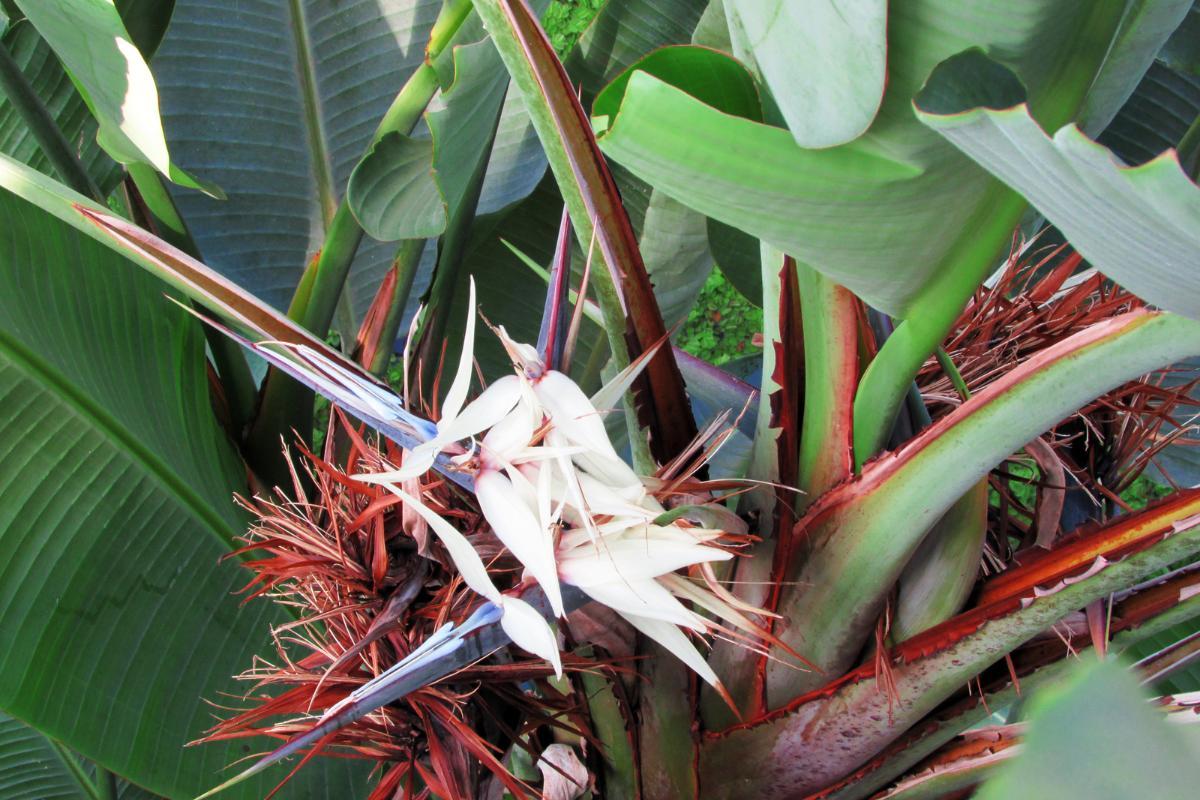Strelitzia Nicolai or Wild Banana Care Guide


The Strelitzia Nicolai, commonly known as the Wild Banana, is a striking plant that brings a tropical touch to any indoor or outdoor space. With its large, lush leaves and tall stature, this plant is a favorite for creating a bold, natural statement. However, to keep your Strelitzia Nicolai thriving, it’s essential to understand its specific care needs, especially when it comes to watering, location, and substrate.
In this guide by thedailyECO, we’ll explore how to care for your Strelitzia Nicolai or Wild Banana plant to ensure it grows healthy and strong.
- Characteristics of Strelitzia nicolai
- Optimal light, temperature, and placement for Strelitzia nicolai
- Recommended substrate and fertilizer for Strelitzia nicolai
- Watering guidelines for Strelitzia nicolai
- Pruning techniques for Strelitzia nicolai
- Reproduction of Strelitzia nicolai
- Common diseases and pests affecting Strelitzia nicolai
Characteristics of Strelitzia nicolai
Strelitzia nicolai, commonly known as the Giant White Bird of Paradise or wild banana, is an evergreen angiosperm native to the tropical and subtropical regions of South Africa. Let us take a closer look at some of its most important characteristics:
- It can reach an impressive height of up to 10 meters (33 feet) under ideal conditions, with a spread of 3 to 4.5 meters (10 to 15 feet). This makes it a popular choice for creating a dramatic visual impact in gardens and large indoor spaces.
- The plant boasts large, banana-like leaves that are deep green and glossy. These leaves can grow up to 1.5 meters (5 feet) in length and 40 centimeters (16 inches) in width. Due to their size, the leaves often tear in windy conditions, giving them a more rugged, palm-like appearance over time.
- One of Strelitzia nicolai's most captivating features is its stunning flowers. These large, bird-like blossoms emerge from a hard, beak-shaped spathe, which gives rise to long-lasting flowers with white petals and blue tongues, resembling exotic birds in flight. The flowers can be up to 18 centimeters (7 inches) long and grow in clusters.
- Strelitzia nicolai is a slow-growing plant, mainly due to the size and weight of its leaves. While it can eventually reach its full height, it takes many years to mature. The plant tends to grow in clumps, with multiple stems rising from a single base, creating a bushy, tree-like appearance.
- Although often confused with Strelitzia augusta, Strelitzia nicolai has several distinguishing features. It grows taller, with a more robust structure, and its leaves are thicker, rounder, and larger. Additionally, its flowers are not only similar to those of augusta, but are also notably larger.
- Strelitzia nicolai is often used as an ornamental plant in gardens, particularly in tropical and Mediterranean climates, where it adds a bold architectural element.
If you're curious about the distinctions between angiosperms and gymnosperms, be sure to explore our related article.

Optimal light, temperature, and placement for Strelitzia nicolai
Strelitzia nicolai thrives in bright natural light but should be protected from intense, direct sunlight during the hottest parts of the day.
While it can tolerate some direct sun, particularly in the morning, excessive exposure to harsh midday sun can scorch its leaves. This is one reason why it's become popular as an indoor plant, where light conditions are more easily controlled. Morning light is ideal for its growth.
In terms of temperature, Strelitzia nicolai is quite adaptable, thriving in a range from 5°C to 30°C (41°F to 86°F). However, it’s crucial to ensure the temperature doesn’t drop below 5°C (41°F), as this can cause damage. Outdoors, it grows best in temperate to warm climates, where it can reach its full size, with larger leaves and stems than when grown indoors. In colder regions, it's best to keep the plant indoors to protect it from frost and cold winds, which can cause wilting or damage.
Whether placed indoors or outdoors, it's important to be patient with the plant as it adjusts to its new environment. Its leaves are naturally adaptive to the surrounding conditions, and it may take time for the plant to settle into a new climate, substrate, or lighting conditions. Wind may occasionally tear the large leaves, but this is normal and won’t affect the plant’s overall health or survival.

Recommended substrate and fertilizer for Strelitzia nicolai
Strelitzia nicolai requires a well-draining, porous substrate to thrive.
A suitable mix can be made by combining equal parts of peat and worm castings (humus), with a handful of perlite to improve aeration and drainage. This ensures the roots don't become waterlogged, which can lead to root rot.
During the growing season, particularly in spring, you can boost its growth by applying a balanced liquid fertilizer, such as a universal fertilizer. Regular feeding will provide the necessary nutrients to support the plant's development throughout this active period.
If you want to understand the differences between compost and fertilizer, be sure to check out our related article
Watering guidelines for Strelitzia nicolai
Strelitzia nicolai is highly sensitive to waterlogging around its roots, which can lead to root rot. It's important to water the plant thoroughly but allow the soil to dry out completely between waterings. To determine if it's time to water again, don't rely on the dryness of the surface alone. Instead, insert your finger or a wooden stick a few centimeters into the soil. If it comes out dry and free of attached soil, it's safe to water again.
During hot weather, it’s beneficial to mist the plant’s stems and roots in addition to regular watering. Although Strelitzia nicolai can tolerate relatively low humidity, increasing the humidity around the plant will promote healthier growth and better overall development.
Pruning techniques for Strelitzia nicolai
Strelitzia nicolai does not require regular pruning. The only pruning necessary is the removal of leaves that have dried out due to age, neglect, or physical damage caused by pests or diseases. Simply trim these damaged leaves to keep the plant healthy and maintain its appearance.

Reproduction of Strelitzia nicolai
Strelitzia nicolai can reproduce both sexually and asexually. Sexual reproduction is achieved by sowing seeds in a substrate rich in worm castings (humus) and keeping the soil consistently moist to encourage germination. This method can take time, as the plant is slow-growing.
Asexual reproduction, which is often easier and faster, involves dividing the plant when it outgrows its pot. To do this, gently remove a young clump from the main plant, carefully loosening the surrounding soil. Once separated, replant the clump in fresh soil in a new pot. This method helps the plant remain healthy and manageable.
Discover more about how plants reproduce asexually and the fascinating methods they use to thrive.
Common diseases and pests affecting Strelitzia nicolai
Strelitzia nicolai can be severely affected by waterlogging of its roots, so it’s essential to avoid excessive watering.
The plant is also susceptible to fungal infections, such as Fusarium, which attacks the roots, as well as Alternaria and Ascochyta, which affect the leaves. To combat these issues, clean the leaves with plain water and apply a small amount of neem oil. You can also manually remove any affected parts to prevent the spread of the fungus. Additionally, using a fertilizer containing copper can help strengthen the plant's immune system.
Regularly removing dust from the large, flat leaves is crucial, as dust can attract pests such as aphids and spider mites.
If you notice that the leaves of Strelitzia nicolai are curling, this may be a response to several factors, such as: inadequate watering, excessive heat, strong winds, or drafts.
Most importantly, a lack of consistent environmental humidity can also trigger this protective response. Be sure to assess these conditions to identify the cause of the curling leaves.
If you want to read similar articles to Strelitzia Nicolai or Wild Banana Care Guide, we recommend you visit our Plant care and cultivation category.
- Azcárraga del Rosette, M.R. (2022). Atlas of plant anatomy. United States: UNAM, Faculty of Higher Studies Cuautitlán.
- Jarrett, A. (2017). Ornamental Tropical Shrubs. United States: Pineapple Press.








